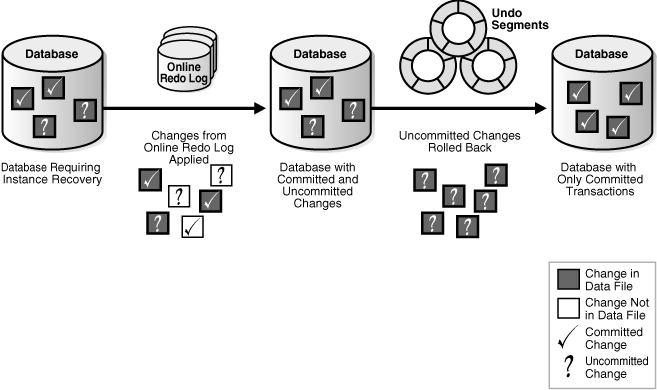共计 2986 个字符,预计需要花费 8 分钟才能阅读完成。
在 Oracle 数据库服务器异常断电重启后,数据库会进行实例恢复,那么实例恢复的过程中 Oracle 做了什么操作呢?参考官网在这里做一下解释,菜鸟水平有限,欢迎勘正。
首先说下实例恢复的定义:
Instance recovery is the process of applying records in the online redo log to data files to reconstruct changes made after the most recent checkpoint. Instance recovery occurs automatically when an administrator attempts to open a database that was previously shut down inconsistently.
Oracle Database performs instance recovery automatically in the following situations:
The database opens for the first time after the failure of a single-instance database or all instances of an Oracle RAC database. This form of instance recovery is also called crash recovery. Oracle Database recovers the online redo threads of the terminated instances together.
Some but not all instances of an Oracle RAC database fail. Instance recovery is performed automatically by a surviving instance in the configuration.
The SMON background process performs instance recovery, applying online redo automatically. No user intervention is required.
因此我们知道非一致性关闭会引发实例恢复(一致性关闭不会,参考 shutdown immediate 的官方定义)同时 RAC 节点宕机也会在一个存活节点进行实例恢复,其过程就是重构内存中的脏块并提交,同时对未提交的做出回滚,这个过程由 smon 后台进程负责。
这里上一幅官网的图:

图:Basic Instance Recovery Steps: Rolling Forward and Rolling Back
Instance Recovery Phases
The first phase of instance recovery is called cache recovery or rolling forward, and involves reapplying all of the changes recorded in the online redo log to the data files. Because rollback data is recorded in the online redo log, rolling forward also regenerates the corresponding undo segments.
Rolling forward proceeds through as many online redo log files as necessary to bring the database forward in time. After rolling forward, the data blocks contain all committed changes recorded in the online redo log files. These files could also contain uncommitted changes that were either saved to the data files before the failure, or were recorded in the online redo log and introduced during cache recovery.
After the roll forward, any changes that were not committed must be undone. Oracle Database uses the checkpoint position, which guarantees that every committed change with an SCN lower than the checkpoint SCN is saved on disk. Oracle Database applies undo blocks to roll back uncommitted changes in data blocks that were written before the failure or introduced during cache recovery. This phase is called rolling back or transaction recovery.
更多 Oracle 相关信息见Oracle 专题页面 http://www.linuxidc.com/topicnews.aspx?tid=12
本文永久更新链接地址:http://www.linuxidc.com/Linux/2017-06/144601.htm
















